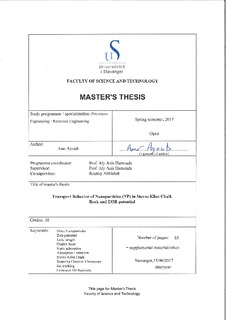| dc.contributor.advisor | Hamouda, Aly | |
| dc.contributor.author | Ayoub, Amr | |
| dc.coverage.spatial | Norwegian continental shelf | nb_NO |
| dc.date.accessioned | 2017-10-27T14:10:06Z | |
| dc.date.available | 2017-10-27T14:10:06Z | |
| dc.date.issued | 2017-06-15 | |
| dc.identifier.uri | http://hdl.handle.net/11250/2462639 | |
| dc.description | Master's thesis in Petroleum engineering | nb_NO |
| dc.description.abstract | This study investigates the adsorption potential of NPs in Chalk cores and the possible EOR mechanisms behind it. The work is divided into two major sets of experiments; static adsorption experiments and core flooding experiments. Static adsorption experiments studies the specific adsorption potential of NPs on the surface of three minerals; Quartz, Kaolinite, and Calcite. Since this work focuses on NPs interactions with Chalk cores, great attention is given to explaining the adsorption that takes place on Calcite mineral and the forces in play as well as comparing the adsorption with the other two minerals. An integral part of studying adsorption of NPs involves performing several measurements on NYACOL DP9711 – source of NPs – to characterize its stability, nominal particle size distribution and its zeta potential at different dilutions in Deionized Water, (DIW) / Synthesized seawater, (SSW) / Low salinity water, (LSW) and at elevated temperatures. The second set of experiments is devoted for core flooding. Core flooding is divided into two main subsets of experiments. The first subset studies the transport and the associated adsorption and desorption that takes place in SK cores. Two cores are flooded with NPs and sample effluents are analyzed intensively. The ion tracking and elemental analysis along with pH allow for underlying the possible major processes that lead to adsorption / desorption and changes introduced to the rock surface. The second subset of experiments, is EOR experiments studying the underlying EOR mechanisms and the potential of Silica Nano Particles as an EOR candidate.
Static adsorption experiments show strong affinity of NPs to adsorb on calcite surface more than quartz and kaolinite. The adsorption is slightly improved in SSW for calcite and this improvement is more pronounced for quartz and kaolinite. From core flooding experiments, adsorption of NPs is proved to take place in chalk cores. The introduction of NP prepared in LSW in chalk cores shows an increment in oil recovery when compared to the primary recovery by LSW and sweep efficiency has improved. | nb_NO |
| dc.language.iso | eng | nb_NO |
| dc.publisher | University of Stavanger, Norway | nb_NO |
| dc.subject | petroleum engineering | nb_NO |
| dc.subject | reservoarteknologi | nb_NO |
| dc.subject | reservoir engineering | nb_NO |
| dc.title | Transport Behavior of Nanoparticles (NP) in Stevns Klint Chalk Rock and EOR Potential | nb_NO |
| dc.type | Master thesis | nb_NO |
| dc.subject.nsi | VDP::Teknologi: 500::Berg‑ og petroleumsfag: 510::Petroleumsteknologi: 512 | nb_NO |
